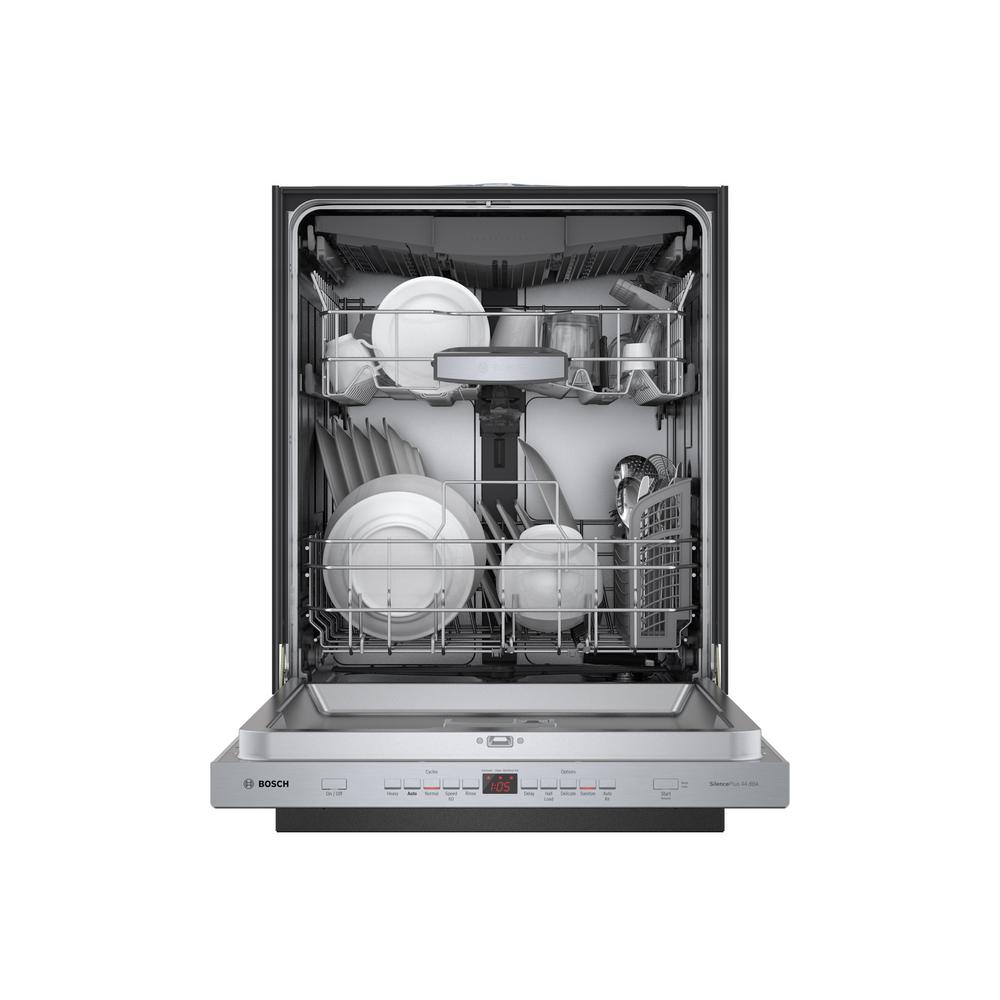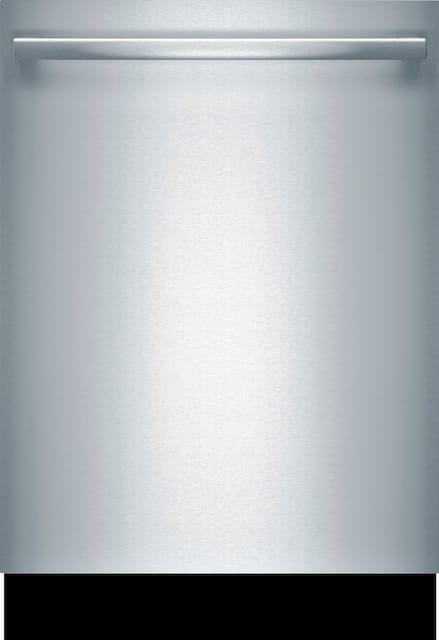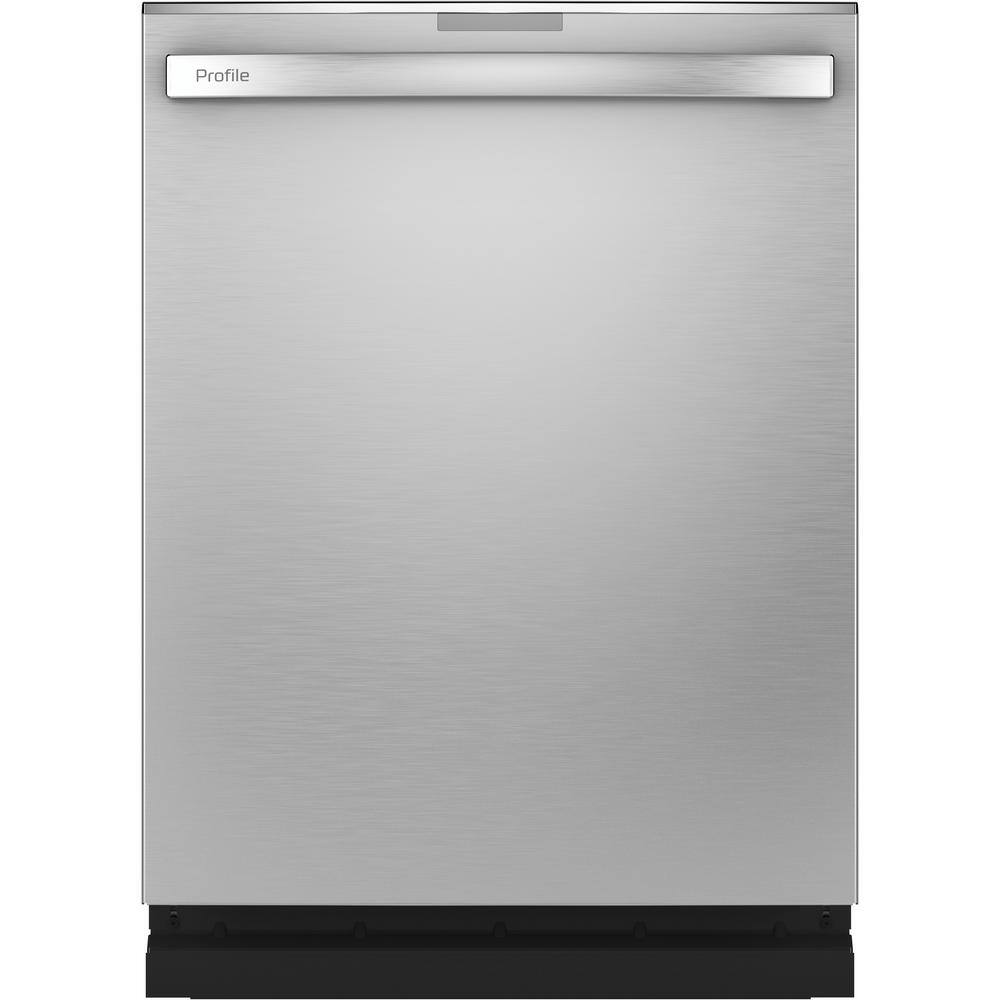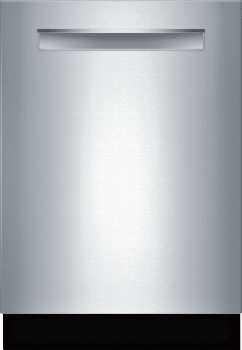Bosch 500 Series 24 in. Stainless Steel Top Control Tall Tub Pocket Handle Dishwasher with Stainless Steel Tub, AutoAir, 44dBA
AutoAir opens the door for drier dishes. Flexible 3rd rack for silverware and cooking utensils. InfoLight shines on the floor so you know if the cycle is running.
The Bosch 500 Series dishwasher delivers a sparkling clean and dry with advanced PrecisionWash technology and AutoAir. With PrecisionWash, intelligent sensors continually scan and check the progress of dishes throughout the cycle, and powerful spray arms target every item of every load, for the ultimate clean. The all-new AutoAir option automatically releases the door at the end of the cycle to let moisture escape and fresh air in for drier dishes.
- Hidden integrated electronic controls maintain a clean exterior and InfoLight shines a red beam on the floor to indicate when the dishwasher is running
- Quiet operation (44 dBA)- incorporates 18 unique sound-reducing technologies such as multiple insulation layers, grindless food filtration, and a sound absorbing base
- Large interior provides loading flexibility necessary to easily accommodate 16 place settings, and the Flexible 3rd rack adds space for cooking utensils and ramekins
- Bosch’s advanced PrecisionWash system has intelligent sensors that continually scan and check the progress of dishes throughout the cycle, and powerful spray arms target every item of every load, for the ultimate clean
- Full stainless steel tub is sleek, durable and long-lasting
- Precisely engineered detergent tray holds detergent tabs in place for a dedicated spray jet to directly dissolve them, preventing buildup for a deeper clean
- Rackmatic adjustable upper rack easily adjusts to 9 different positions, to allow taller items like stemware to fit in the middle rack while leaving room for bulky items below. The flip tines make loading wide bowls easy and ball bearing wheels provide a smooth glide
- FlexSpace Tines on the lower rack- fold down every other tine in one simple step to make room for larger, bulkier items while optimizing the rack space
- Flexible 3rd Rack with fold down sides adds 30% more loading area compared to a Bosch dishwasher with 2 racks, perfect for utensils and ramekins
- Precisely engineered and laser cut, the precision spray arms aim water directly at dishes for the ultimate clean while minimizing noise
- Sanitize Option reduces 99.9% of bacteria with a hot-wash rinse for sparkling clean and sanitized dishes
- Half Load Option allows you to load half of the normal dishes anywhere in the dishwasher to reduce water usage without sacrificing wash performance
- A dishwasher water connection kit is required for installation
Additional information
| Cut-Out Depth x Height x Width (in.) | 24 x 33.88 x 23.63 |
|---|---|
| Depth - Door Shut (with Handle) (in.) | 23.75 |
| Depth - Door Shut (without Handle) (in.) | 23.75 |
| Depth With Door Open 90 Degrees (In) | 48.4375 |
| Dishwasher Size (In.) | 24 |
| Height - Maximum (in) | 35.0625 |
| Height - Minimum (in) | 33.875 |
| Product Depth x Height x Width (in.) | 23.75 x 33.875 x 23.563 |
| Certifications and Listings | CSA Listed,Energy Star,NSF Certified,UL Listed |
| Manufacturer Warranty | 1 Year Limited |
24 may refer to:
- 24 (number), the natural number following 23 and preceding 25
- one of the years 24 BC, AD 24, 1924, 2024
A dishwasher is a machine that is used to clean dishware, cookware, and cutlery automatically. Unlike manual dishwashing, which relies on physical scrubbing to remove soiling, the mechanical dishwasher cleans by spraying hot water, typically between 45 and 75 °C (110 and 170 °F), at the dishes, with lower temperatures of water used for delicate items.
A mix of water and dishwasher detergent is pumped to one or more rotating sprayers, cleaning the dishes with the cleaning mixture. The mixture is recirculated to save water and energy. Often there is a pre-rinse, which may or may not include detergent, and the water is then drained. This is followed by the main wash with fresh water and detergent. Once the wash is finished, the water is drained; more hot water enters the tub by means of an electromechanical solenoid valve, and the rinse cycle(s) begin. After the rinse process finishes, the water is drained again and the dishes are dried using one of several drying methods. Typically a rinse-aid, a chemical to reduce the surface tension of the water, is used to reduce water spots from hard water or other reasons.
In addition to domestic units, industrial dishwashers are available for use in commercial establishments such as hotels and restaurants, where many dishes must be cleaned. Washing is conducted with temperatures of 65–71 °C (149–160 °F) and sanitation is achieved by either the use of a booster heater that will provide an 82 °C (180 °F) "final rinse" temperature or through the use of a chemical sanitizer.
A handle is a part of, or attachment to, an object that allows it to be grasped and manipulated by hand. The design of each type of handle involves substantial ergonomic issues, even where these are dealt with intuitively or by following tradition. Handles for tools are an important part of their function, enabling the user to exploit the tools to maximum effect. Package handles allow for convenient carrying of packages.
A pocket is a bag- or envelope-like receptacle either fastened to or inserted in an article of clothing to hold small items. Pockets are also attached to luggage, backpacks, and similar items. In older usage, a pocket was a separate small bag or pouch.
Stainless may refer to:
- Cleanliness, or the quality of being clean
- Stainless steel, a corrosion-resistant metal alloy
- Stainless Games, a British video game developer
- Stainless Broadcasting Company, a TV broadcaster based in Michigan, US
- Stainless Banner, the second national flag of the Confederate States of America
Steel is an alloy of iron and carbon with improved strength and fracture resistance compared to other forms of iron. Because of its high tensile strength and low cost, steel is one of the most commonly manufactured materials in the world. Steel is used in buildings, as concrete reinforcing rods, in bridges, infrastructure, tools, ships, trains, cars, bicycles, machines, electrical appliances, furniture, and weapons.
Iron is always the main element in steel, but many other elements may be present or added. Stainless steels, which are resistant to corrosion and oxidation, typically need an additional 11% chromium.
Iron is the base metal of steel. Depending on the temperature, it can take two crystalline forms (allotropic forms): body-centred cubic and face-centred cubic. The interaction of the allotropes of iron with the alloying elements, primarily carbon, gives steel and cast iron their range of unique properties. In pure iron, the crystal structure has relatively little resistance to the iron atoms slipping past one another, and so pure iron is quite ductile, or soft and easily formed. In steel, small amounts of carbon, other elements, and inclusions within the iron act as hardening agents that prevent the movement of dislocations.
The carbon in typical steel alloys may contribute up to 2.14% of its weight. Varying the amount of carbon and many other alloying elements, as well as controlling their chemical and physical makeup in the final steel (either as solute elements, or as precipitated phases), impedes the movement of the dislocations that make pure iron ductile, and thus controls and enhances its qualities. These qualities include the hardness, quenching behaviour, need for annealing, tempering behaviour, yield strength, and tensile strength of the resulting steel. The increase in steel's strength compared to pure iron is possible only by reducing iron's ductility.
Steel was produced in bloomery furnaces for thousands of years, but its large-scale, industrial use began only after more efficient production methods were devised in the 17th century, with the introduction of the blast furnace and production of crucible steel. This was followed by the Bessemer process in England in the mid-19th century, and then by the open-hearth furnace. With the invention of the Bessemer process, a new era of mass-produced steel began. Mild steel replaced wrought iron. The German states were the major steel producers in Europe in the 19th century. American steel production was centred in Pittsburgh, Bethlehem, Pennsylvania, and Cleveland until the late 20th century. Currently, world steel production is centered in China, which produced 54% of the world's steel in 2023.
Further refinements in the process, such as basic oxygen steelmaking (BOS), largely replaced earlier methods by further lowering the cost of production and increasing the quality of the final product. Today more than 1.6 billion tons of steel is produced annually. Modern steel is generally identified by various grades defined by assorted standards organizations. The modern steel industry is one of the largest manufacturing industries in the world, but also one of the most energy and greenhouse gas emission intense industries, contributing 8% of global emissions. However, steel is also very reusable: it is one of the world's most-recycled materials, with a recycling rate of over 60% globally.
Tall commonly refers to:
- Tall, a degree of height
- Tall, a degree of human height
Tall may also refer to:
Top most commonly refers to:
- Top, a basic term of orientation, distinguished from bottom, front, back, and sides
- Spinning top, a ubiquitous traditional toy
- Top (clothing), clothing designed to be worn over the torso
- Mountain top, a mountain peak located at some distance from the nearest point of higher elevation
Top may also refer to:
Tub may refer to:
- A tub (container):
- a round or oblong container with or without a lid:
- a plant pot
- a shallow, plastic or paper container, typically with a lid or closure
- Tub (unit), a former quantity for sale or butter or cheese
- a round or oblong container with or without a lid:
- A bathtub, a plumbing fixture for bathing
- Hot tub, a large bath or small pool designed to comfortably hold multiple persons
- Quarry tub, a type of railway or tramway wagon
- Slack tub, in blacksmithing, a quench
- Tub boat, an unpowered cargo boat used on early canals
- Twin tub, a type of washing machine
- Tub file, in computing, an early, primitive random access memory technology.
- Tub Welch, a baseball player.
TUB may refer to:
- TUB (gene)
- Citroën TUB, a light van
- Technische Universität Berlin (Germany)
- Transports Urbains du Beauvaisis, local public transport operator in northern France
- Tubuai – Mataura Airport (IATA airport code)
TUBS or Tubs may refer to:
- Time unit box system, a system for notating events that happen over a time period.
- Tokai University Boarding School in Denmark
- Ryan Tubridy, Irish television and radio presenter.
With or WITH may refer to:
- With, a preposition in English
- Carl Johannes With (1877–1923), Danish doctor and arachnologist
- With (character), a character in D. N. Angel
- With (novel), a novel by Donald Harrington
- With (album), a 2014 album by TVXQ
- With (EP), a 2021 EP by Nam Woo-hyun






by Kris
We are so very pleased with the quality of the washing and its very quiet operation. It is several light years ahead of our previous washer. We highly recommend it to you.
by Melanie
When we did a remodel this year we decided on buying Bosch appliances. We couldn’t be more happy with the quality of the washed dishes, and how quite the dishwasher runs.
by Ronnie
Had a little problem with an error code but the tech had it fixed in no time and the dishwasher runs great! Its so quiet you really have to listen to hear it operating. The dishes come out sparkling clean and I have no complaints as of right now. I would recommend to a friend.
by Bob
Likes: stainless steel Tub, Very quiet, 3rd rack Variety of cycles Dislikes: rack height not adjustable, Flatware receptacle not on inside of door which would free up space on lower rack.
by Harry
Researched a number of dishwasher brands before settling on Bosch. Made the right choice. Cleans dishes, glasses and silverware spotless and have to listen real close to hear it running. Looking forward to many years of use.
by Erin
We have two dishwashers in our kitchen. Both of our kitchenaids went on the fritz the same week after 13 years. I decided to test out the Bosch by leaving peanut butter on a knife and a plate, and dried out egg yolks on a plate. To my surprise, the knife and plates came out perfectly clean. I also like that Tupperware can go in the bottom rack because there is no heating element to melt the plastic. The third top rack is great for spatulas and tongs. These items come out clean. I follow the manufacturer’s directions and use “auto” and “sanitize” and have had no problem with drying. I just love these machines. The pocket handle took a little getting used to. We had to go with it because there is a shortage of materials for machines and the Bosch with pocket handles was the only option available in the high end products. Now I really like the handles. It seems to keep drips down the front stainless steel at a minimum.
by Burly
This machine is impressively quiet when running. I’m so glad that we chose it.
by Kimmie
Very quiet and cleans well.